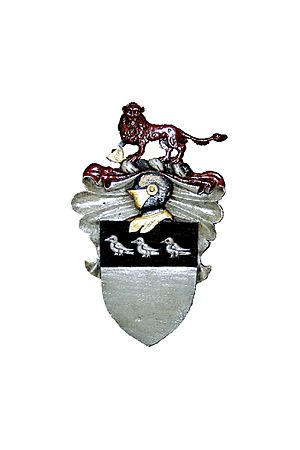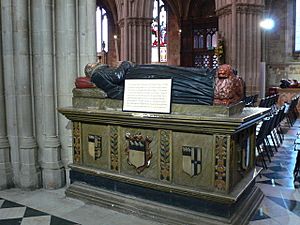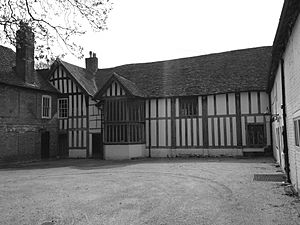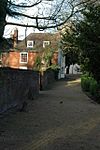Thomas Wylde (clothier) facts for kids

Thomas Wylde (born before 1508 – died 1559) lived in The Commandery in Worcester, England. He was a very rich and important merchant who sold cloth.
Contents
Who Was Thomas Wylde?
Thomas Wylde was the son of Simon Wylde. Simon lived at The Ford, which was near a place called Dodderhill. Later, Thomas bought a large area of land there called the manor of Impney.
Thomas Wylde's Important Jobs
Serving in Parliament
Thomas Wylde was chosen to be a Member of Parliament (MP) for Worcester. An MP is someone who represents their town or area in the country's government.
He was first elected in 1551. This was to fill a spot that became empty in the Parliament of 1547. He was elected again in 1558, not long before he passed away.
Working for Worcester City
Thomas Wylde held many important jobs in the city of Worcester:
- Chamberlain: 1545–1546 (This job was like managing the city's money.)
- Bailiff: 1547–1548 (A high-ranking city official.)
- Alderman: 1548 (A senior member of the city council.)
- Bridgemaster: 1554–1555 (Someone in charge of the city's bridges.)
- Member of Parliament: (first elected) 1551
- Member of the Twenty-Four: 1555 (Part of a group that helped run the city.)
- Auditor: 1555–1556 (Someone who checked the city's accounts.)
Building a Business Empire
By the end of the Middle Ages, Worcester had grown a lot. About 10,000 people lived there. Making cloth became a huge business in the area. Worcester was even given special status as a "county corporate." This meant it could mostly govern itself, separate from the local county government.
Thomas Wylde was a clothier. This means he made and sold cloth. People believe he became very rich when a war stopped the wool trade with the Low Countries (like modern-day Belgium and Netherlands). His business in Worcester was so successful. Worcester was a major center for making cloth back then.
After King Henry VIII closed down many monasteries, Thomas Wylde bought a large old religious building in Worcester. It was called the Hospital, but people knew it better as "The Commandery." When he died, his house had 31 rooms! One room even had 20 feather beds. The Wylde family owned The Commandery until 1785.
The Commandery's Story
Thomas Wylde bought The Commandery in 1544. He bought it from Richard Morrison, who worked for King Henry VIII. The Commandery was originally a hospital for St Wulfstan. It was founded around 1085, or maybe a bit later. It was used as a place for poor people to live (an almshouse) and also offered a place for travelers to stay.
The Commandery is just outside Worcester's Sidbury Gate, on the road to London. It had been empty since 1540, after the king closed down the monasteries. Like many places owned by the Knights of St John of Jerusalem, it kept the name "Commandery." The building you see today was mostly built in the late 1400s. It's made of wood with brick or plaster added later.
During the final battle of the Third English Civil War in 1651, The Commandery became very important. Thomas Wylde's great-great-grandson, also named Thomas Wylde (1622–1669), lived there. It was used as the headquarters for King Charles II's Royalist army. The Duke of Hamilton died there after being wounded and refusing to have his leg removed.
In the 1900s, The Commandery became a famous museum about the Civil War. There's an old hill in the grounds that was used to defend Sidbury Gate. It was made stronger in 1651 and is now called Fort Royal. Fort Royal and its park are now separated from the house by a road called Wyld(e)'s Lane.
- The Commandery, outside Sidbury Gate, Worcester
Thomas Wylde's Family


Thomas Wylde was married twice:
- First, before 1529, he married Alice Ledington (also called Sudington). She was the daughter of Robert Ledington. They had one son and two daughters. Their son was:
- Robert Wylde (around 1535-1608). He was the oldest son and inherited his father's property. Robert married Margaret Cowling. His tomb, with statues of him and his wife, is still in Worcester Cathedral.
- Second, he married Eleanor Wall. She was the daughter of George Wall and the widow of Edward Corbett. They had two sons and one daughter, including:
- George Wylde (1550–1616). He lived at Heryots in Droitwich and was an MP for Droitwich three times.
His Death
Thomas Wylde passed away on August 11, 1559. This was soon after Queen Elizabeth I became queen on November 17, 1558.
Helping Others: Charitable Gifts
Worcester Free School
While he was an MP, Thomas Wylde helped get money from the King for a schoolmaster. He then gave land called Little Pitchcroft and part of Great Pitchcroft to help start the Free School again. He also supported the Trinity almshouses (places for the poor to live). By 1848, the money from these gifts was helping the school and almshouses a lot.
Other Gifts
Thomas Wylde's will (his last wishes) has mostly been lost. But some parts that still exist in Worcester city records show he made many gifts. He made sure his wife, children, brothers, sisters, and fathers-in-law were taken care of.
He also left money for the poor, asking them to pray for his soul. He gave money to fix the roads between Worcester and Kempsey. He also set aside money to help 20 poor young women in Worcester get married within two years of his death. Each would receive 20 shillings.
He gave more land to the city. This was on the condition that they would build a free school within two years. This school would teach young people basic reading and religious lessons. This would prepare them for the King's grammar school. If the city didn't build the school, the land would go back to his family.
He also gave black coats and money to his apprentices and journeymen (people learning a trade). His maid servants received black gowns and money too. His wife and son Robert were in charge of making sure his wishes were carried out. His father-in-law Wall, father-in-law Ledington, and cousin Heywood were asked to oversee the will.
The Wylde Family Legacy
The Wylde family continued to be important. After The Commandery was sold in 1785, the main family line continued in Shropshire. Later, they added the name Browne to their family name, becoming Wylde-Browne.
One notable family member was Edmund Wylde (1618–1695). He had no children, so he left his large estates (lands and property) to Thomas Wylde (1670–1740) of The Commandery. This allowed Thomas to serve in Parliament nine times between 1701 and 1727.







